Leaves, Branches, Berries and Blooms

Podcast: Play in new window | Download
Subscribe: Apple Podcasts | Podcast Index | RSS | More
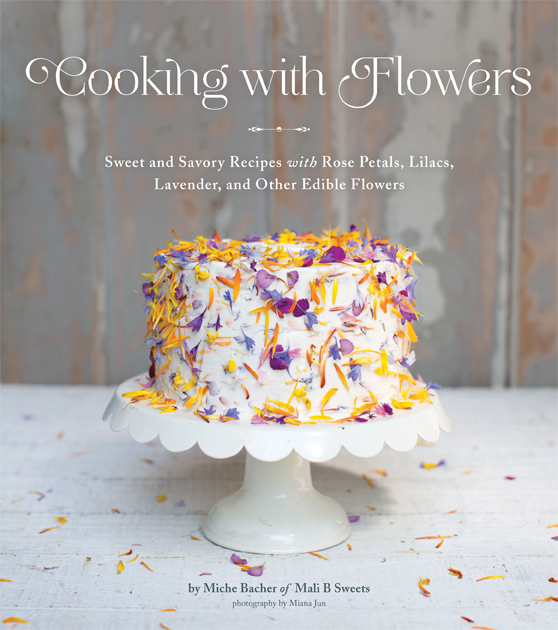
Featured on the cover of “Cooking with Flowers” is Miche’s “Flowerfetti” Calendula Orange Cake. Flower petals are the “original cake confetti,” she maintains. Roses, dianthus, bachelor buttons and marigold petals adorn this enticing confection.
Today we’re going to talk about eating flowers.
Yes, flowers as food.
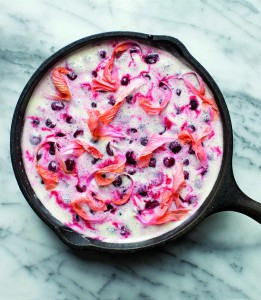
Hollyhock Clafouti, a cross between a custard, a pancake, and a puffy omelet. Uses 1 cup hollyhock petals.
I once had a big-time New York editor say to me: Why should I care about how flowers are grown, anyway? After all, we don’t eat them!
As a response to that challenge, I wish I had been able to pull out “Cooking with Flowers,” the most eye-satisfying book I’ve ever seen. It was created by Miche Bacher, an herbalist, chef, and founder of the custom confectionary studio Mali B Sweets.
To WIN a free copy of “Cooking with Flowers,” courtesy of Quirk Books, listen to to my interview with Miche and make a comment below about the best edible flower tip you learned. I will draw a winner at random on Tuesday, October 22nd at 5 p.m. Pacific.
I learned about this beautiful cookbook from Mari Malcolm, an editor at Amazon who absolutely loves “Cooking with Flowers.” Mari showed me the book’s beautiful cover on her phone screen during a lunch we had together this past spring.
I keep ordering this delectable book and then giving it away as a gift to my flower lover-friends. And now, it is my great pleasure to spend this episode of Slow Flowers in a floral-focused conversation with Miche.
In her introduction, Miche writes:
“Flowers add color, complexity, and what I like to call the magical ‘what’s in it’ factor to your food. They are full of nutrients and often offer health benefits, too. You don’t have to be a master gardener or a trained chef to cook with flowers – once you start looking, you’ll realize edible blossoms are all around you, and it really is a breeze to use them.”
She is definitely a chef whose work begins in the garden. Through “Cooking with Flowers,” I’ve gained new inspiration for another important reason to appreciate local flowers.
I know you will learn much from my conversation with Miche, as we discuss her favorite culinary ingredients, including the lowly dandelion.
![Fresh and candied lilac flowers are the captivating ingredient in Miche's "Coconut Lilac Tapioca," a recipe in her book, "Cooking with Flowers" [photo: (c) Miana Jun, used with permission]](https://www.slowflowerspodcast.com/wp-content/uploads/2013/10/CoconutLilacTapioca-1024x411.jpg)
Fresh and candied lilac flowers are the captivating ingredient in Miche’s “Coconut Lilac Tapioca,” a recipe in her book, “Cooking with Flowers” [photo: (c) Miana Jun, used with permission]
![4 tablespoons of dianthus petals, coarsely chopped, infuse this delicious cake that also includes 2/3-cup rose' wine. Dianthus whipped cream and candied dianthus flowers are a perfect embellisment. [photo: (c) Miana Jun, used with permission]](https://www.slowflowerspodcast.com/wp-content/uploads/2013/10/PinkRosecake-903x1024.jpg)
4 tablespoons of dianthus petals, coarsely chopped, infuse this delicious cake that also includes 2/3-cup rose’ wine. Dianthus whipped cream and candied dianthus flowers are a perfect embellisment. [photo: (c) Miana Jun, used with permission]
Here are some links we discussed in the interview:
Mali B’s Edible Flower Chocolate Collection:
Memorial Sloan-Kettering Cancer Center LINK to Herbs, Botanicals & Other Products:
Click here for MORE about COOKING WITH FLOWERS, including exclusive recipes that Miche couldn’t fit into the book. You’ll also find bonus recipes for the medicinal and cosmetic use of flowers, salves, oils, and teas for healing; download recipe cards and read a Q&A with this talented woman.
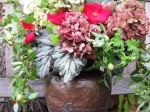
Detail: An autumn bouquet from a Tuscan garden. Olives, roses, hydrangeas, scented pelargonium leaves, Rex begonia leaves – seen here.
This morning at the villa, two friends went off for watercolor lessons with resident expat artist Liz Cochrane.
After walking down to Il Barrino for hot tea and a croissant, I came back totally determined to make a bouquet for our group’s last night together.
We have a dinner coming in from Allesandro, the local chef (Marty organized the menu, which includes Ribollita, a Tuscan soup; sliced pork with balsalmic vinegar; zucchini flan; and that popular italian desert, Apple Pie!)
The Flower Arrangers’ Guild of Tuscany commenced its first session.
This garden is in its waning moments of late summer-early autumn. But it does not disappoint. So much to work with and we judiciously snipped, without hurting or denuding a single plant.
I had spotted a copper urn, weathered and slightly dented, sitting on the floor in the Lemonaio (the garden room). It inspired my palette – faded, tarnished and of the moment.
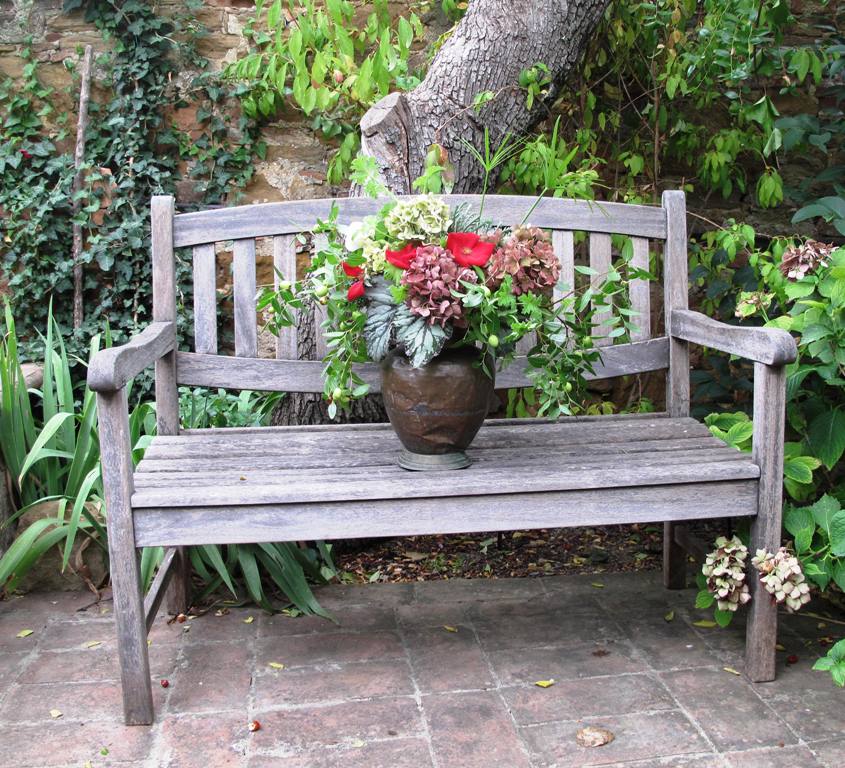
A rustic wooden garden bench, a perfect place to display and photograph my Tuscan bouquet in a timeworn copper vessel.
Here are the ingredients I began with:
1. Scented pelargonium foliage
2. Papyrus stems from the water pond
3. Hydrangeas – two types
4. Roses – two types
5. Olives branches w/fruit
6. Marguerite daisy foliage
7. Rex begonia foliage
Mary Watson joined me in the garden, eager to make something beautiful. She made two adorable bouquets:
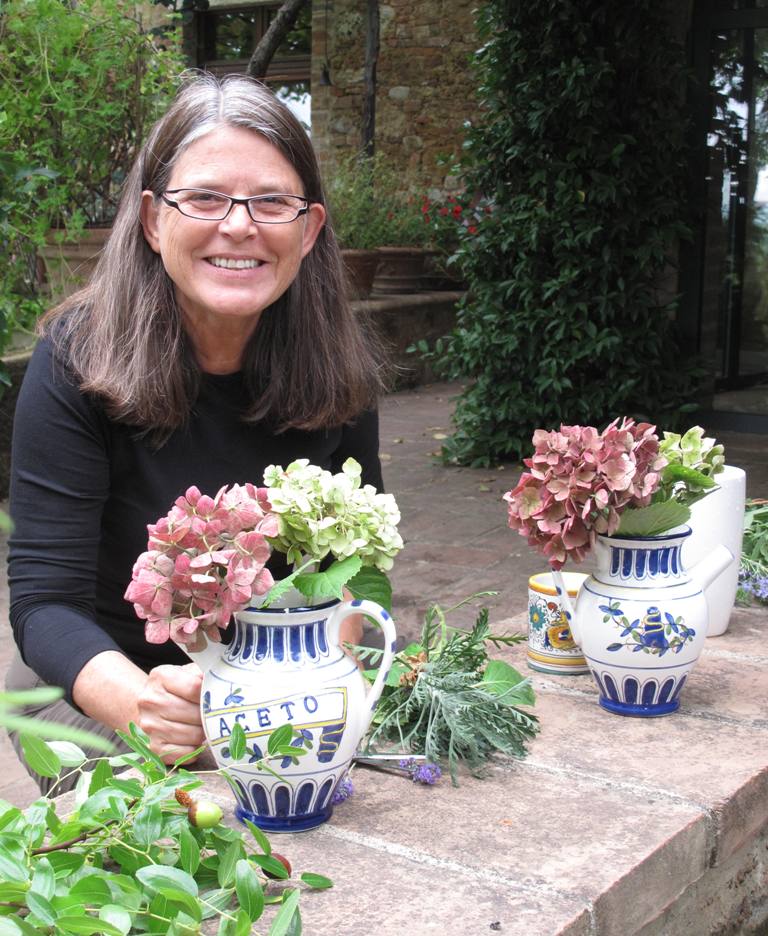
Mary Watson, a new friend who I met through Marty Wingate. She is an art educator and bon vivant! Right when I started arranging this morning, Mary jumped into the fun.
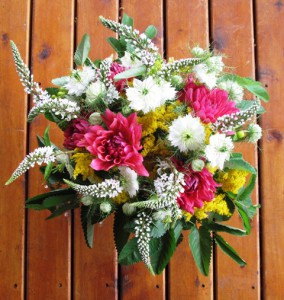
This charming arrangement is even more interesting when viewed from the top as the gooseneck stems appear to be flying in all directions!
Ingredients:
7 stems Dahlia ‘Coral Gypsy’, grown by Jello Mold Farm
15 stems white love-in-a-mist (Nigella damascena), grown by J. Foss Garden Flowers
5 stems chartreuse Hypericum perforatum (a florist’s variety selected for its colorful fruit), grown by Jello Mold Farm
7 stems goldenrod (Solidago sp.), grown by J. Foss Garden Flowers
11 stems white gooseneck loosestrife (Lysimachia clethroides), grown by Jello Mold Farm
20 stems burnet foliage (Sanguisorba obtusa), grown by Charles Little & Co.
Vase:
6-inch tall x 4-inch diameter glass vase
Eco-technique
Transporting bouquets: Save your arrangement and your car with a smart stabilizing trick I learned from flower farmers who make frequent bouquet deliveries. Use a box that is at least half the height of your vase; seal the
top and bottom so you have an empty “cube.” Using a utility knife, cut a large X on one side of the box. The cuts should be approximately the same size as the vase diameter. Push the bottom of the vase into the X-opening. The
triangular cardboard flaps created by the cuts should bend inward to hold the vase securely while you drive.
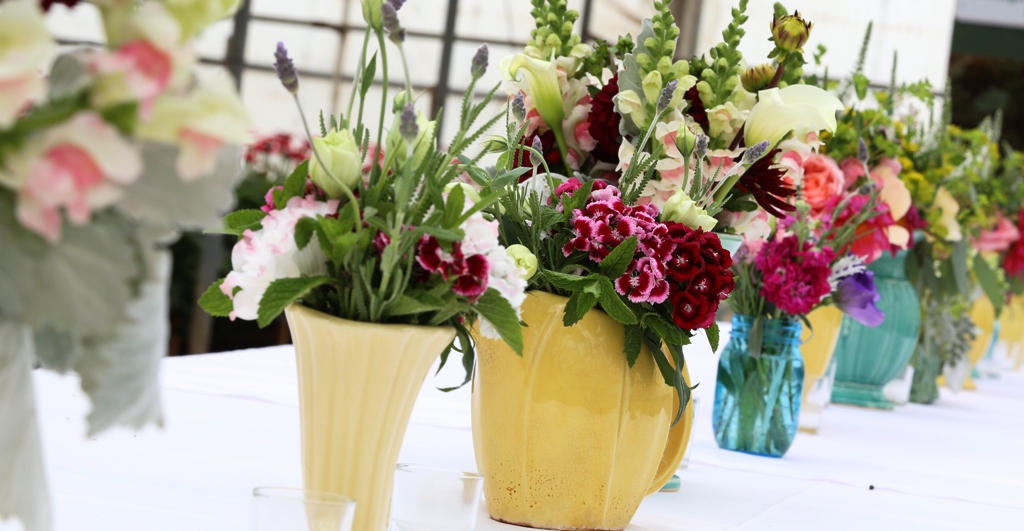
Imagine a table set for 40 . . . inside a flower-filled greenhouse. Vintage vases overflowing with just-picked blooms adorn the table and a locally-grown menu is served.
Last month I joined with the California Cut Flower Commission to host a “Slow Flowers” dinner as part of the 2013 Monterey Bay Greenhouse Growers Open House & Tour.
We called it “Farm-to-Table; Field-to-Vase” and held the dinner in the gerbera-filled greenhouse at Kitayama Bros. Farms in Watsonville, California. The event was a gathering of like-minded persons. Each of us — farmer, florist, media, community advocate — cares deeply about the role of American flowers in the greater agricultural environment. And everyone in attendance contributed an important voice around the table, a table with locally-grown food and locally-harvested flowers.
I was on the road last week, working in Oregon for six days (counting 1,000-miles of travel). My companions were James Baggett, editor-in-chief of COUNTRY GARDENS magazine and photography team Laurie Black and Mark King of Laurie Black Photography.
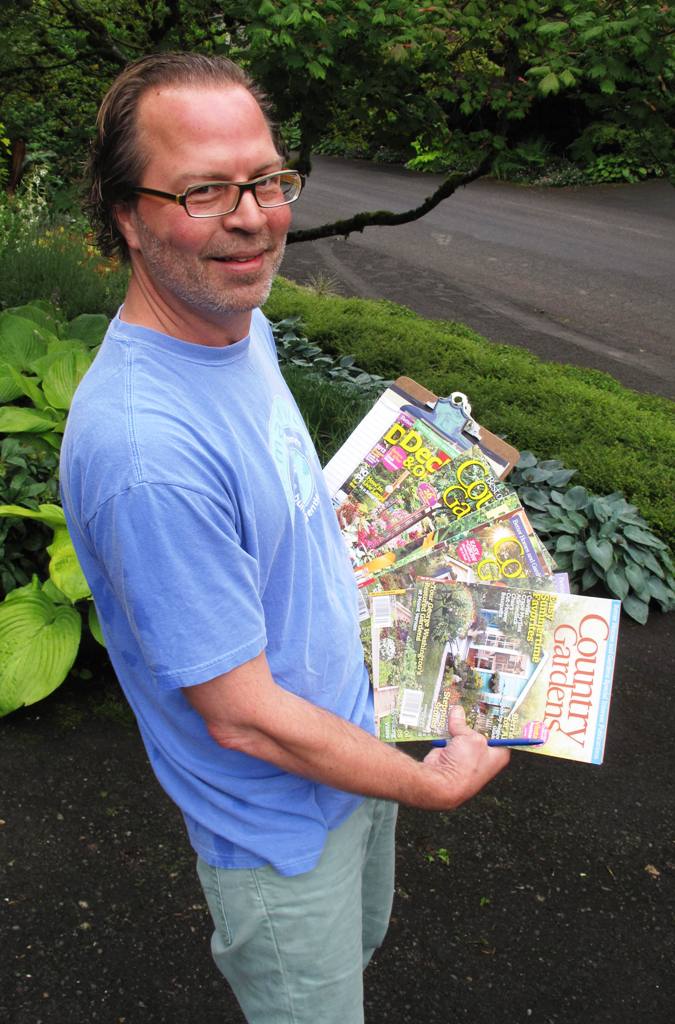
James Baggett, showing off the many titles he creates with coworker Nick Crow, his art director. It’s simply mind-boggling to grasp their huge productivity – and it’s an honor to be one of their writer-producers.
We spent the week photographing awesome landscapes, inspiring new plants and a fabulous farm-to-fork dinner (complete with locally grown, organic wine, food and flowers). A busy schedule, but filled with great experiences. It will be my privilege to write the stories to accompany Laurie’s photos for publication in 2014.
I’ll keep this short. I mostly have photos to share.
With the arrival of spring here in Seattle, we flower lovers have lots to celebrate! That’s because the wistful beauty coming from our local flower fields, meadows and farms are simply sublime.
When I stepped inside the Seattle Wholesale Growers Market two days ago, I was stopped in my tracks. The botanical abundance in each stall made me catch my breath with happiness~ A new season is upon us – hurrah!!!
I brought home arm-loads of goodies, enough to make three lovely arrangements of three different sizes. The common threads are these blooms, including some clipped from my own garden. and the style of vase. I cannot resist a footed urn!
As noted above, my vase(s) of choice are footed urns or bowls. All three used here are vintage and quite dear to me.
I hope that seeing how I used them inspires you to snatch up a footed vase or bowl, an urn or anything with a pedestal base – they are indeed the superior vessels for showcasing flowers. If you frequent vintage sites online, flea markets or garage sales . . . maybe you’ll be just as lucky as I have been. I’ve used vintage metal flower frogs inside each. The frogs are like half-dome cages and because they are metal, they’re heavy enough to just sink to the bottom of the vessel (no tape or stickum required).
Constance Spry wrote about one of her favorite vases — a footed marble bowl — in her 1933 book Flower Decoration. I can only imagine how pricey one of these vases would be today! Here’s what she had to say:
“This vase is beautiful to look at whether empty or filled with flowers. It is so heavy that it is not disturbed by the heaviest branches of fruit or blossom, and its soft, pale-brown colour enhances whatever one chooses to put in it.”
Here are the designs that gave me so much pleasure:
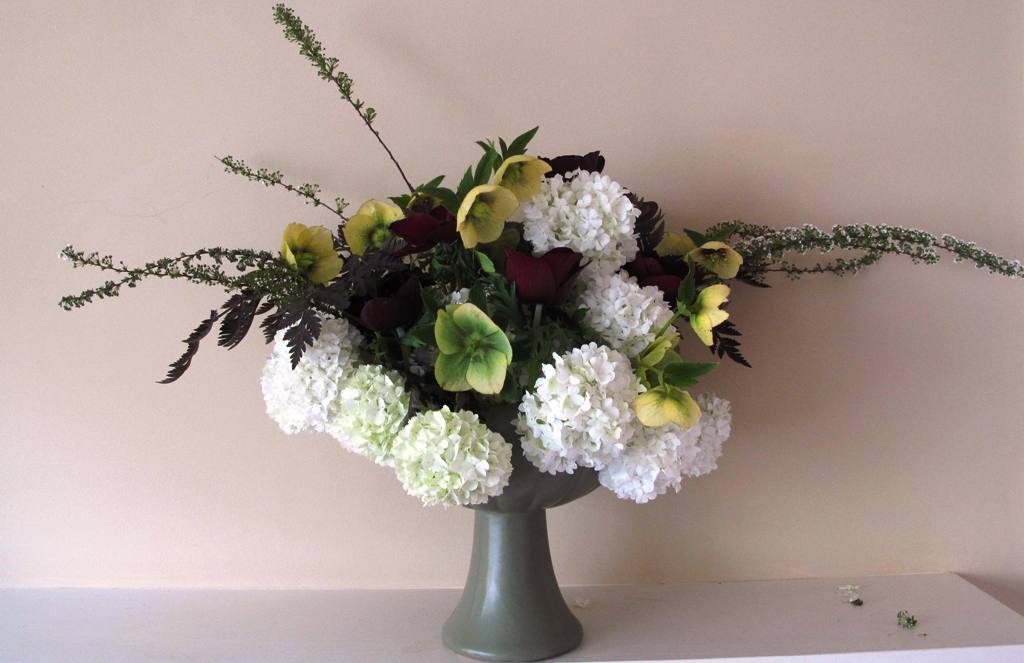
A Green Floraline Pedestal Bowl, featuring snowball viburnum, hellebores, anemones, Anthriscus foliage and bridal wreath spirea.
After I created and photographed this arrangement, I decided to see how it looked WITHOUT those spikey branches. So here’s version 2 of the same bouquet:
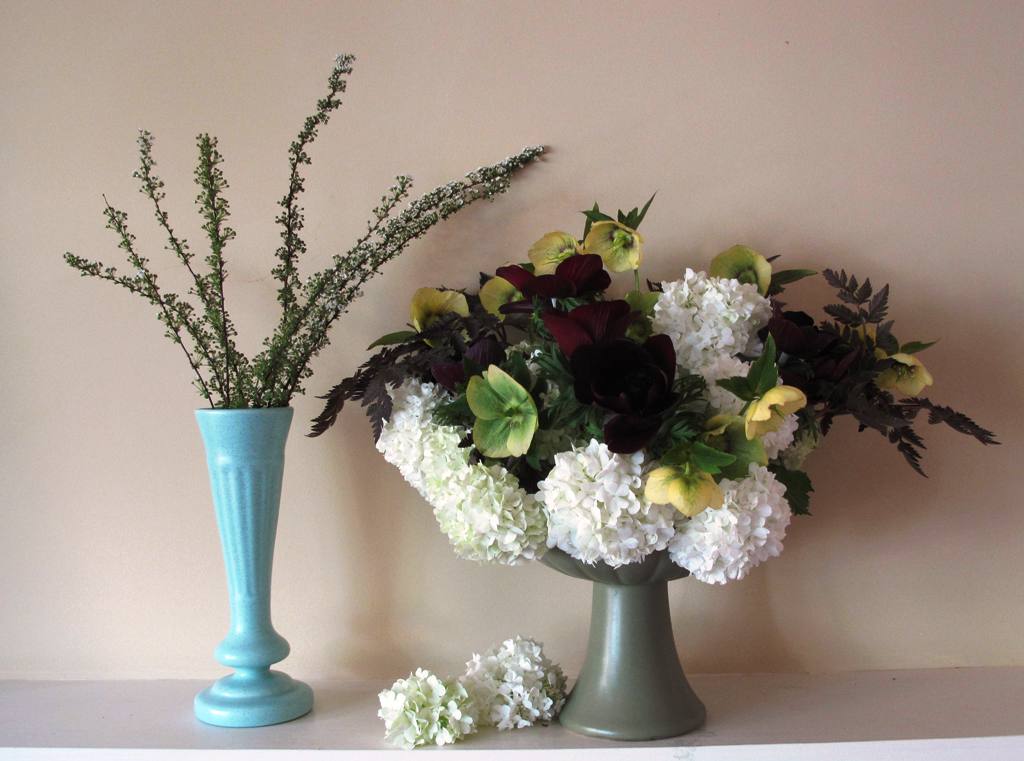
The spirea moved into the teal blue Haegar (vintage) bud vase, while the green Floraline footed bowl contains the remaining blooms.
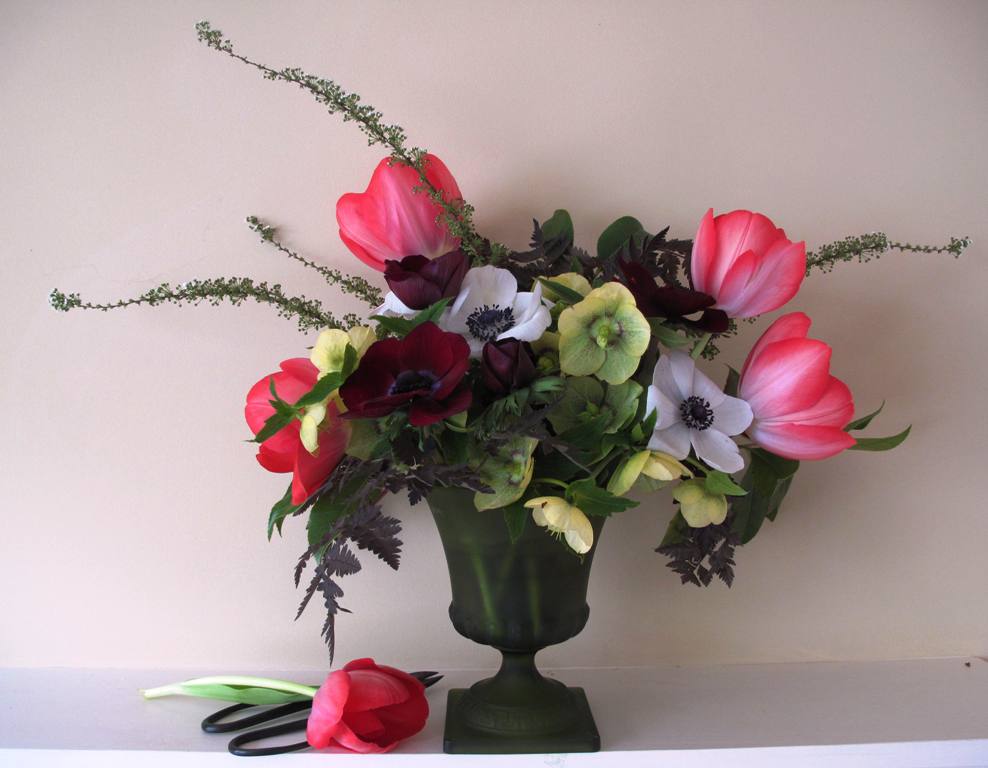
With hellebores, white and burgundy anemones, salmon pink tulips, Anthriscus foliage, camellia foliage and bridal wreath spirea.
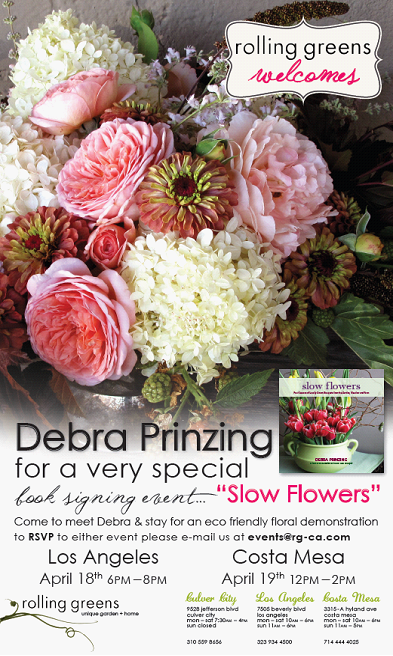
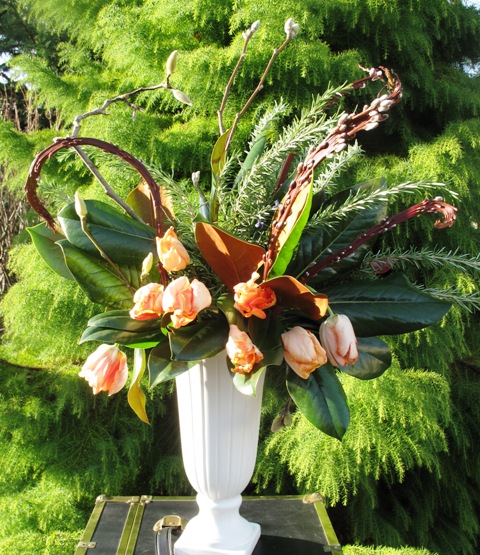
Evergreen magnolia (Magnolia grandiflora), parrot tulips, rosemary, Japanese fantail willow and bare magnolia branches in bud fill one of my favorite white vases.
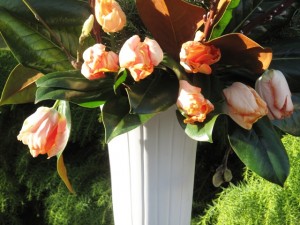
A sweet detail of those luscious tulips – don’t they play nicely with the rusty side of the magnolia foliage?
Ingredients:
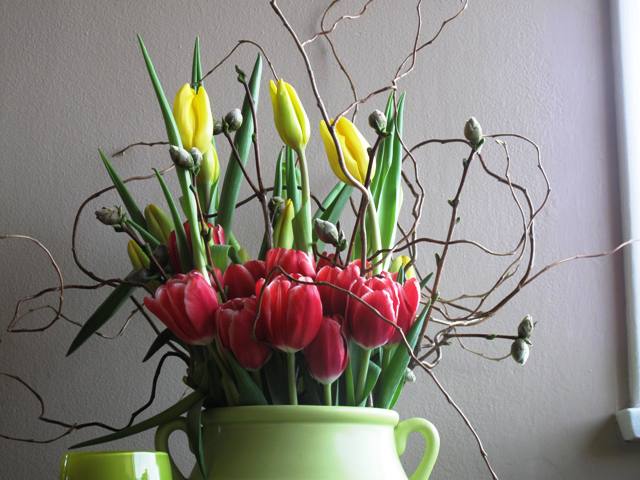
My cover shot, a perfect way to kick off springtime! Tulips, willows and camellia branches – all contained in a brilliant, matte green urn.
NOTE: Each Sunday of this year, I will post my photographs, “recipe” and tip for that week’s floral arrangement, created for my new book, Slow Flowers. Enjoy the floral journey through 52 weeks of the year~
Living a life guided by intentional choices is something we advocate in The 50 Mile Bouquet.
In the introduction, I wrote:
Faced with concerns about our food supply, the materials with which our homes are built and furnished, and the energy sources we consume, more people than ever are asking questions about the environmental impact of everything they use, drive, eat and even wear.
And yet, until recently, conscious consumers were largely unaware of the decidedly non-green attributes of their floral purchases. They bought bouquets without questioning the source, or the manner in which those flowers were grown (not to mention the environmental costs of shipping a perishable, luxury commodity around the globe). . . .
Whether or not they consider themselves environmentalists, consumers are beginning to exercise their choices at the flower stand, asking whether the beautiful roses, lilies or tulips they purchase at the local supermarket were grown domestically or were imported.
The message is that making intentional choices, especially as consumers, allows us to be conscious and holistic about using our resources wisely.
Of course, the Slow Food movement is way ahead of the floral world in this respect. And when our mutual friend Lois Pendleton introduced me to Zoe Bartlett, creator of Intentional Table, I instantly understood that we spoke the same language.
The message of Intentional Table is one that resonates:
Over the past 18 months, Zoe has been developing her business concept with a vision for creating community around the table, connecting purveyors with diners, educating and inspiring, and sharing local resources with like-minded customers. She has teamed up with Linda Brandt and the two recently debuted the Bainbridge Island flagship store of Intentional Table. The storefront is located on the pedestrian-friendly Madrone Lane, just off of Winslow Way. Here’s what the island’s community newspaper had to say about Intentional Table.
They opened the doors of their beautiful emporium-culinary studio on November 24th, Thanksgiving weekend.
I’ve been trying to make it over to Bainbridge Island ever since. Today was one of those magical, non-scheduled days (made even more special because our December temperatures reached a high of 48-degrees). I took the ferry from downtown Seattle, not worrying about the schedule, but just paying for my ticket and getting in line to calmly wait for the next departure. As the ferry-boat pushed away from the downtown Seattle waterfront, I snapped a few touristy photos, which I’d love to share with you here:
The new Seattle Great Wheel is quite stunning. Read more about it here.
Read more about the Space Needle here.
After a 35-minute crossing, we arrived on Bainbridge Island and I headed a short distance to downtown Winslow. I have a lot of friends living on the island, including the amazing garden owners featured in The Abundant Garden, the book I wrote to accompany Barbara J. Denk’s beautiful photography (Cool Springs Press, 2005).
But today, my goal was to visit Zoe’s new venture. It was so great to walk inside and see her there, bustling about to help customers, share samples of gourmet chocolate, demonstrate cool products like wine decanters and unique vases.
Because it’s a holiday week, lots of out-of-towners wandered in, including a young sommelier from New York City and a gourmet nut entrepreneur who took a specialty food business development class from Zoe a few years ago. Lots and lots of people arrived, in search of hostess gifts. Conversations among strangers wove together.
There was no huge effort to *explain* what Intentional Table meant. People understood. Everyone expressed curiosity about the upcoming cooking class schedule that Zoe and Linda will soon announce. Then, by summer, there will be food-centric educational dining experiences, staged all around the Northwest. I can’t wait!
One of the reasons Zoe’s vision resonates so much with me is that she views the Intentional Table as not just about food. To her, anything that we put on our tables – from the food and wine to the flowers in the vase – needs to reflect the place we live. I love that!
So you can definitely look for my participation in future events at this wonderful destination.
Together, we’re hoping to create several hands-on, seasonal floral design workshops that celebrate local flower farms and engage customers with the growers in their own community.
To sign up for Intentional Table announcements/newsletters, please click here.
Here are more photographs of this beautiful food & wine studio:
© Debra Prinzing, all written and photographic content. Website design/development by Willo Bellwood/Metric Media